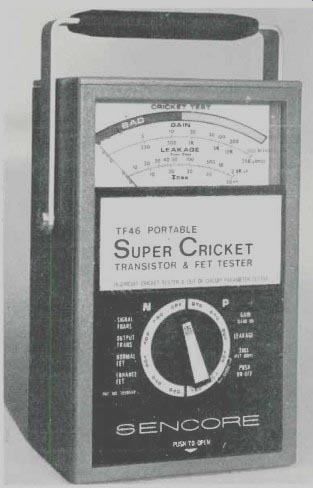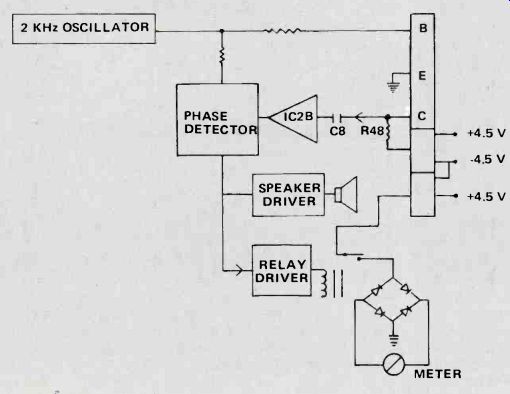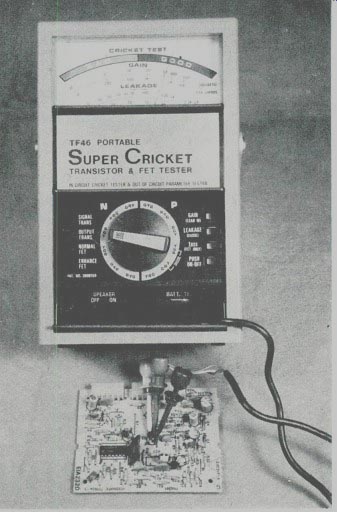By Carl Babcoke, CET
Each report about an item of electronic test equipment is based on examination and operation of the device in the ELECTRONIC SERVICING laboratory. Personal observations about the performance, and details of new and useful features are spotlighted, along with tips about using the equipment for best results.

---- Model TF46 Portable Super Cricket Transistor --- And FET Tester
from Sencore operates from internal battery cells. A door slides meter
face, to protect it during transportation. The test lead compartment,
at the bottom, is closed for the picture.

----- Figure 1 After the permutator switch has been set correctly,
a 2-KHz square-wave signal is fed to the base of the transistor (that's
being tested), and bias of the proper polarity is applied to the emitter.
A sample of the base signal, and a sample of the inverted square waves
from the collector, go to a logic phase detector. When both signals are
present, the meter and the speaker tone are activated. (Courtesy of Sencore)
Sencore Family Of Cricket Testers
One feature of all Sencore-series transistor testers is the audio tone that sounds during successful in-circuit and lead-identification tests. The audio sound probably suggested the name of Cricket; but, don't expect a Cricket to chirp one short sound and then stop. The audio tone is continuous until switched off.
Model TF26, the first Cricket, tested only the ability of a transistor to amplify a test signal, and it required AC power. It was followed by the Super Cricket TF30, also an AC model, which in addition to the basic good/bad Cricket test, checked gain and leakage out-of-circuit.
Now there are two new versions, both portable, with batteries or an AC adapter. Model TF40 Pocket Cricket gives a good/bad in-circuit test, along with identifications of polarity and leads. The latest one is model TF46, the Super Cricket, that's described here.
All Crickets operate on the premise that no other circuit component can produce a phase-inverted output signal. Therefore, square waves are applied to the base, and the collector signal is examined for out-of-phase square waves. If they are present in sufficient amplitude, the transistor must be amplifying; and the meter reading and Cricket tone from an internal speaker indicates a good transistor. (See Figure 1.) Also, Crickets have switches for connecting all possible combinations of the three leads, in both polarities. These six combinations for each polarity allow the transistor to be connected to the Cricket test leads in any random order. Then, after the Cricket tone is obtained by operation of the switches-the knob pointer and the color sequence of the panel marking opposite it identify which transistor elements are connected to the red, green, and yellow test leads. Thus, the leads are identified during the test.

Figure 2 In the center is the permutator-switch pointer, which selects
all combinations of leads and polarity. The eight pushbuttons at the
sides select the conditions and functions. The gain, IDSS, and leakage
buttons are the only ones that do not latch. The SPEAKER OFF/ON switch
can be seen dimly at the left bottom; it is at the back of the storage
compartment. The BATT TEST switch is shown at the right bottom corner.
Figure 3 The five scales of the TF46 meter are, from top to bottom: good/bad Cricket and battery test; 0 to 500 beta for bipolar transistors; 0 to 25K micro-ohms for FETs; 0 to 2,500 microamperes for transistor leakage; and 0 to 50 milliamperes for FET leakage.

Figure 4. The Sencore TF46 Super Cricket is shown giving a "good" Cricket
in-circuit reading of a transistor on a Magnavox module.
Model TF46 Cricket
The full name of the TF46 (Portable Super Cricket Transistor & FET Tester) tells us that both bipolar and FET transistors can be tested. In smaller letters, it also says: "In-Circuit Cricket Tester & Out-Of-Circuit Parameter Tester." Therefore, you should perform first the Cricket in-circuit lead-identification and good/bad tests. Then, if the result is "bad," the transistor should be removed for accurate tests out-of-circuit.
This sequence is necessary and logical, because in-circuit tests must fail when the impedances are less than 50 ohms. In other cases, the collector-versus-emitter lead identification might be indecisive.
In-circuit tests offer convenience, while out-of-circuit tests provide accuracy.
One new feature is the automatic power-shutoff circuit that turns off the battery power after ten minutes of operation. This prevents ruining the batteries when you forget to turn off the machine. Of course, power can be restored for another 10 minutes by a couple of pushes on the on-off button.
Testing with the TF46 Here is the proper sequence of tests for bipolar transistors:
Connect the EZ-Hook insulated clips of the TF46 cable to the transistor; it's not necessary to match colors and transistor leads;
Depress only the PUSH ON-OFF switch (it should latch);
Rotate the large "permutator" test knob (Figure 2) either CW or CCW;
Stop rotating the knob when you find two adjacent positions that give a meter reading near the center of the green "good" meter area, plus a continuous tone from the internal speaker. (Normal bipolar transistors provide low gain when the collector and emitter are reversed, and the Cricket test is so sensitive that a gain of less than 2 will activate the "good" test)
The six switch positions at the left are for N (NPN) polarity transistors, and the six at the right are for P (PNP) polarity transistors. Therefore, the polarity of the transistor has been determined;
Read the color code (of the transistor wires and hooks) at the end of the pointer, which has E, B, and C (for emitter, base, and collector). As shown in Figure 2, Y is next to E; so the yellow wire is connected to the emitter. G is next to B (the green wire is connected to the base), and R is by the C (the red wire is connected to the collector). Of course, the S, G, and D (for source, gate, and drain) for FETs are there, too. Therefore, the position of the permutator switch indicates the elements of the transistor. But, the collector and emitter might be interchanged, so another step is required to determine which is collector and which is emitter;
Select SIGNAL TRANS, if the transistor is small; or push the OUTPUT TRANS button, if the transistor is a power type. (These buttons latch, and stay in position;)
Press the GAIN button (and keep pressing it during the next test, for it does not latch); and
Turn the permutator switch alternately to the two positions that gave the Cricket tone, noticing the gain reading on the meter. The position that shows the higher gain reading provides the correct transistor-connection color code.
Some circuit impedances are so low that both gain readings in-circuit are nearly unreadable. If there is no significant difference of the readings, the device might be an FET (see page 20 of the Sencore instruction booklet). Or, it is a bipolar type which reads virtually no gain in-circuit. In such cases, you must guess at the identity of collector and emitter; or you should remove the transistor for a more-accurate out-of-circuit gain test.
Leakage of a transistor and its circuit can be read by continuous pressing of the LEAKAGE button (none of the buttons on the right latch), while you rotate the permutator switch. The various tests are explained in the instruction booklet.
Leakage tests made when the transistor is out-of-circuit measure the leakage of the transistor only.
Similar tests are provided for FETs, and a separate scale is included on the meter face (Figure 3).
Meter Power
The TF46 operates from six size "AA" cells. Zinc-carbon or alkaline cells can be used alone. When an optional external PA202 AC adapter is added, it supplies the power, and the cells act as filters (don't use the adapter without any cells). If Ni-Cad cells are used, the adapter charges them. A switch at the bottom of the test-lead storage compartment allows the battery condition to be read on the good/bad meter scale.
Comments
Many transistors were checked with the Sencore TF46 Cricket, and not one false answer was obtained.
The tester does not indicate whether a transistor is made of germanium or silicon; but that lack is typical of many testers. An ohmmeter test of one junction will show you which material is used in the transistor.
No Cricket response was obtained with a horizontal-output transistor, nor with a series-pass power supply regulator. Those transistors should be removed for out-of-circuit checks.
I don't know of any tester that can check those transistors in-circuit.
A Cricket tone and meter reading were obtained for all of the small (signal) transistors in a modular color TV (see Figure 4). The high in-circuit leakages proved why most of them did not give usable gain readings. However, the gain of several emitter followers checked about right.
In summary, the Sencore model TF46 Super Cricket transistor tester was easy to operate, and no wrong diagnosis of good or bad transistors was made during our extensive tests.
(adapted from: Electronic Servicing magazine, Dec. 1977)
Also see: Reports from the Lab (Feb. 1978)